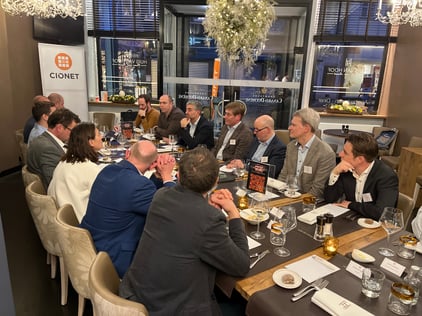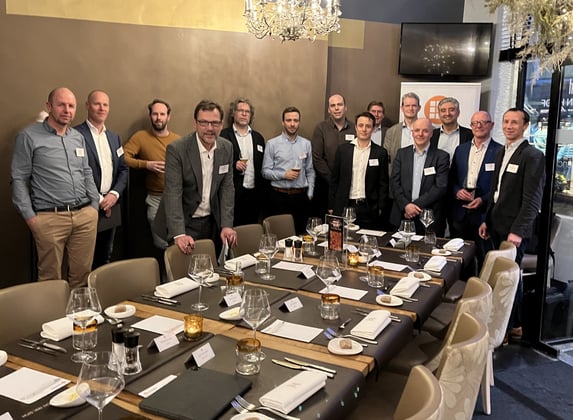Interest in low-code has increased markedly over the past year. This was the second roundtable CIONET, in collaboration with Mendix, set up on the theme of low-code, and the seats around the table were - so to speak - immediately 'sold out'. Asked about their motivation, participants answered that they wanted to learn from the practical experiences of the speakers on the poster to make decisions. Either because they are "considering" the use of low-code in their organisation or because they have some pilots running today and need to decide to "industrialise" or go more mainstream with low-code. Or they are struggling with questions such as: "Is citizen development a viable option?" and " To what extent can you motivate and involve business colleagues in developing (Low-code) applications?".
-1.png?width=623&height=350&name=BE20230309%20-%20Mendix%20(1)-1.png)
The poster for this roundtable was impressive, showing two gentlemen with a strong track record in low-code projects: Sami Chabbah, director of digital channels at Proximus, brought the story of a 'super app' Proximus is developing with low-code in close collaboration with partners and suppliers. And Gert Vanhaecht, director of IT at Belfius Bank and responsible for the various banking and non-banking business applications (Digital Channels, Front Frameworks & Customer Care Center Applications, Payments, Credits, Securities, Financial Markets & Referential Systems), came to explain the place of Low-code within their IT strategy.
The critical question is: "Is it fit for purpose?". What can you do with Low-code, and what should remain regular custom software development? The bankers around the table left no doubt: core banking applications are a no-go zone anyway. As Geert Leekens, Enterprise Architect at Engie, also noted: "Nuclear is excluded by definition for low-code applications. The strict (internal and external) requirements towards control and governance are far too high there to 'experiment' with low-code developments".
Sami Chabbah's story
Sami added another dimension to the "fit for purpose" question. "After all", Sami explained, "Low-code has outgrown its infancy. Today, there is a mature universe of low-code platforms, each covering different needs and business domains". In this context, Proximus chose a BPM (Business Process Management) oriented platform to build Proximus' ordering orchestration solution, as it is a particularly complex process within a telecom environment. But for developing the future successor to MyProximus, Proximus+, the Mendix platform came out first in the benchmark study. The new app should become a hub integrating a broad range of services - including beyond-telecom-related ones - from the Proximus' ecosystem of partners and suppliers. The ultimate goal is to make users' lives as easy as possible by offering them a multitude of commonly used services in one single environment. Here, the decision was made to go for a greenfield app, starting with an MVP (Minimum Viable Product). All options had to be kept open. The environment had to be flexible and agile, allow easy and incremental integration or withdrawal of services via APIs, and, above all, be scalable. The latter was crucial. Because what started as a prototype has now grown into a full-fledged application that will have to serve more than 2 million users.
 And in the meantime, what are Sami's main lessons learned? "Provide a centre of excellence, from the very beginning - separate from the software development factory - that defines a framework of guidelines and standards and trains enough people to use them". And he adds, "Beware of deviating from what is available on the platform. Do not try customising Low-code, as you will lose your agility. Make sure not to create technical debt: applications that are difficult to maintain and will require more time and energy afterward.
And in the meantime, what are Sami's main lessons learned? "Provide a centre of excellence, from the very beginning - separate from the software development factory - that defines a framework of guidelines and standards and trains enough people to use them". And he adds, "Beware of deviating from what is available on the platform. Do not try customising Low-code, as you will lose your agility. Make sure not to create technical debt: applications that are difficult to maintain and will require more time and energy afterward.
Still, according to Henk, Enterprise Account Executive of Mendix, Sami's story is an atypical one in the sense that most companies realise their first low-code projects with low-risk small or internal applications with a limited number of users, preferably with a simple logic, before gradually building up to larger and more business-critical applications.
Belfius, has a history of already more than 20 years with low-code
Gert Vanhaecht has worked at the bank known today as Belfius for over 20 years. And as of the beginning, the bank worked with an in-house developed low-code platform to develop screens to be used by the agents during customer-facing conversations and by the operations divisions. A 2nd generation of this platform made it possible to develop applications integrated with banking and mobile apps and could be developed by non-IT-savvy colleagues. Here too, the Low-code platform was centralised, a strong library of components was built, and sufficient governance and a framework of standards were set up to ensure robust applications, before decentralising in the different teams.
In addition, Belfius launched a new strategic plan a few years ago. The objective is to set up an IT platform for the long term, say ten years, cloud-enabled but with a large degree of autonomy. The first ideas went in the direction of a package, but this path was quickly deserted for a pragmatic approach based on an architecture heatmap. The first domain tackled in this process was the loans platform, where the front end was developed in Low-code (Mendix). The latter should connect with various hybrid back-end systems and provide customers with a seamless, consistent experience. Here, too, an MVP was developed, which was then gradually expanded and equipped with the necessary integrations with the core banking systems. Today, the loan team intends to have its own Low-code development platform, subject to central governance from the IT team. And in the meantime, there are other - mainly customer-facing - applications being built entirely in Low-code. Belfius has reached a level where decisions need to be made to go Low-code enterprise-wide, for front applications for agencies, bankers on the road, and operations divisions, but without touching the core banking applications, as indicated earlier.

Citizen development: believers and non-believers
Gert and Sami are not believers in widespread citizen development. People need specific expertise to develop appropriately, even in Low-code. There is also the question of maintenance and ownership. (Who should rush to the rescue if the application crashes at night?) You need solid central governance of IT anyway to avoid impediments.
Other tablemates also pointed out the inherent risks of citizen development, such as creating an inextricable tangle of applications throughout the company. According to them, IT must continue to play its central role. The IT team should inspire the business and do the technological translation for them. Low-code development by the business is possible but after professional consideration of the risks and installing the necessary coaching and governance. Some of the tablemates - let's say the more mature low-code environments - were working by the principle that business teams can realise their own Low-code projects in different places within the organisation. But, once these reach a certain size and maturity, they are centralised and placed under the care of central IT.
In short, Low-code gives the space to encourage creativity and innovation, to quickly set up MVPs or prototypes... And disband them again if it doesn't provide the hoped-for results. Following the principle "fail fast, learn fast". But, the choice of application, set-up, supervision and framing of a Low-code project should be the subject of a robust management process.
Special thanks go to our speakers Gert Vanhaecht & Sami Chabbah and to all participants:
- Frank Lemmens
- Isabelle Roucou
- Philippe Coffyn
- Geert Leekens
- Ive Callaerts
- Benjamin Minard
- Dimitri Van Antwerpen
- Vincent Goelen
- Bart Smets
- Evert Delanghe
- Lloyd Siberdt
- Henk Stobbe
- Menno Odijk
-1.png)
-1.png?width=623&height=350&name=BE20230309%20-%20Mendix%20(1)-1.png)
 And in the meantime, what are Sami's main lessons learned? "Provide a centre of excellence, from the very beginning - separate from the software development factory - that defines a framework of guidelines and standards and trains enough people to use them". And he adds, "Beware of deviating from what is available on the platform. Do not try customising Low-code, as you will lose your agility. Make sure not to create technical debt: applications that are difficult to maintain and will require more time and energy afterward.
And in the meantime, what are Sami's main lessons learned? "Provide a centre of excellence, from the very beginning - separate from the software development factory - that defines a framework of guidelines and standards and trains enough people to use them". And he adds, "Beware of deviating from what is available on the platform. Do not try customising Low-code, as you will lose your agility. Make sure not to create technical debt: applications that are difficult to maintain and will require more time and energy afterward.
No Comments Yet
Let us know what you think